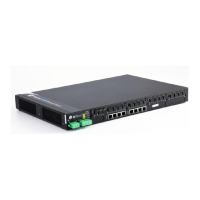13–4 MULTILINK ML3000 ETHERNET COMMUNICATIONS SWITCH – INSTRUCTION MANUAL
RAPID SPANNING TREE PROTOCOL CHAPTER 13: RAPID SPANNING TREE PROTOCOL
13.2 Configuring RSTP through the Command Line
Interface
13.2.1 Normal RSTP
The commands to setup and configure RSTP are as follows. The set stp command sets
the switch to support RSTP or STP. It is necessary to save and reboot the switch after this
command.
set stp type=<stp|rstp> -
The
rstp command enters the RSTP configuration mode and enables/disabled RSTP. By
default, RSTP is disabled and has to be manually activated.
rstp
rstp <enable|disable>
rstp <romode|normal>
The syntax for the
port command on RSTP is shown below.
port port=<number|list|range> [status=<enable|disable>] [migration=<enable>]
[edge=<enable|disable>] [p2p=<on|off|auto>]
The
p2p parameter sets the “point-to-point” value to off on all ports connected to shared
LAN segments (i.e. connections to hubs). The default value is
auto. P2P ports would
typically be end stations or computers on the network.
The
edge parameter enables/disables all ports connected to other hubs, bridges and
switches as edge ports.
The
migration parameter is set for all ports connected to devices such as hubs, bridges
and switches known to support IEEE 802.1d STP services but not RSTP services
The
show active-stp command displays whether STP or RSTP is running.
show active-stp
The
show stp command display the RSTP or STP parameters.
show stp <config|ports>
Note
Users may notice extended recovery time if there is a mix of firmware revisions in the Mesh
or Ring.
The variables listed by the
show stp config command are:
• Rapid Spanning Tree Enabled (Global): Indicates whether STP is enabled or
disabled globally i.e. if the values is YES, all ports have STP enabled, otherwise, all
ports have STP disabled.
• Rapid Spanning Tree Enabled Ports: Indicates which ports have RSTP enabled.
• Protocol: Indicates whether STP or RSTP is being used. It also indicates if RSTP is
used in Smart RSTP (ring-only mode) or normal mode.
• Bridge Priority: Specifies the switch (bridge) priority value. This value is used along
with the switch MAC address to determine which switch in the network is the root
device. Lower values mean higher priority. Values range from 0 to 65535 with a
default of 0.
• Bridge Forward Delay: Indicates the time duration the switch will wait from
listening to learning states and from learning to forwarding states. The value
ranges from 4 to 30 seconds with a default of 15.

